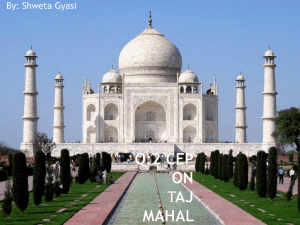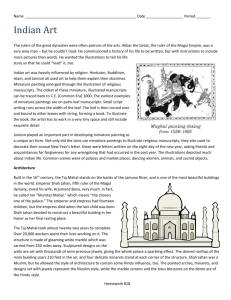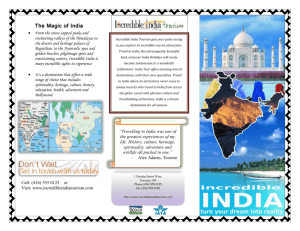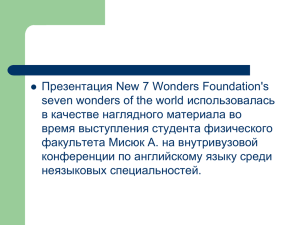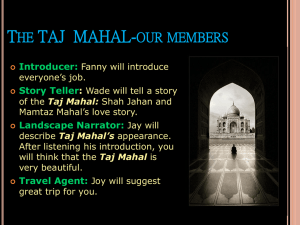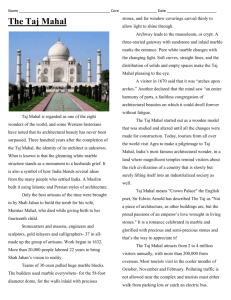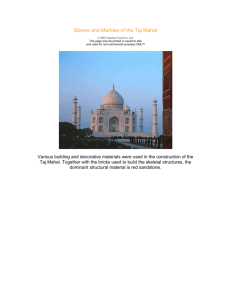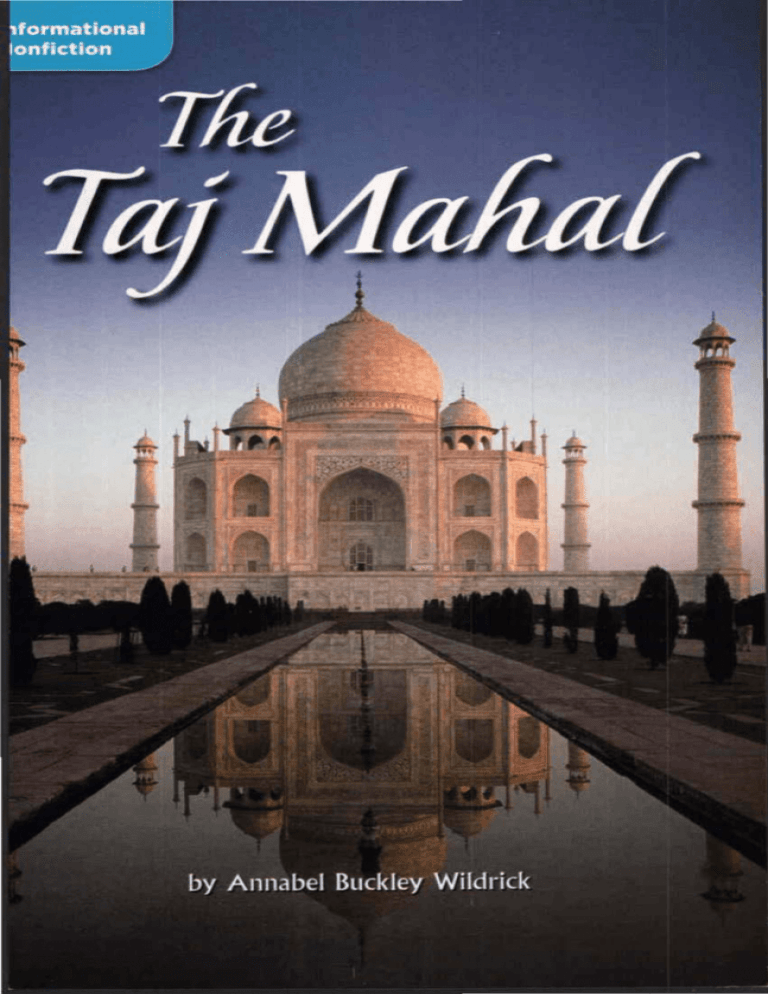
�­
•
Read to
Fi:n.d Out
I
•
Strategy: Generate Questions
I
•
Skill: Make Generalizations
What makes great
architecture? What
questions would
you ask the builder
of the Taj Mahal?
I
Vocabulary
•
I
I
I
I
I
I
I
I
STRATEGIES & SKILLS AT A GLANCE
•
I
I
Comprehension
•
I
commissioned, elaborate,
envisioned, miniature, philosopher,
I
proportion, recommend,
I
Renaissance
I
I
Vocabulary Strategy
I
•
Word Parts: Greek Roots
•
�
.....
-
-
-
-· ·-
;-
-
-
-
#
CONTENT-AREA VOCABULARY
Words related to architecture
photo credits COVER: (bkgd) Brian A Vikander/
CORBIS. 1: (c) David Buffington/Gerty Images. 2: (b)
Miles Ertman/Masterfile. 4: (br) Burstein Collection/
CORBIS. 5: (tc) Wetzel and Company; (tr) The Granger
Collection, New York. 7: (t) Wetzel and Company; (b)
Abbie Enock; Travel Ink/CORBIS. 8: (b) Eric and David
and culture
(see glossary)
Hosking/CORBIS. 10: (t) Brian A Vikander/CORBIS II:
(b) Wetzel and Company; (tr) Jeremy Woodhouse/
Maslerflle 13: (all) akg-images I Jean-Louis Nou,
(t)
Wetzel and Company. 14: (t) lindsay Hebberd/CORBIS
15: (b) Peter Guttmon/CORBIS 16: (t) mediacolor's/
Alamy. 17: (b) David Buffington/Getty Images. 18·
(be) Victoria & Albert Museum/Art Resource, NY; (b)
Glenn Mitsui/Getty Images. 19: (b) Hugh Sitton/Aiomy
Images. 20: (t) Kamal Kishore/Reuters/CORBIS. 21· (b)
#332139 Index Stock Imagery, Inc
CONTENT STANDARDS
Social Studies
•
Culture
Word count: 1,776**
8
The McGrow·Hill Companies
B
t::mli
Macmillan
McGraw-Hill
Published by Macmillan/McGraw-Hill, of McGraw-Hill Education, a division of
The McGraw-Hill Companies, Inc., Two Penn Plaza, New York, New York 10121.
Copyright© by Macmillan/McGraw-Hill. All rights reserved. No part of this publication
may be reproduced or distributed in any form or by any means, or stored in a database or
retrieval system, without the prior written consent of The McGraw-Hill Companies, Inc.,
including, but not limited to, network storage or transmission, or broadcast for distance
learning.
Printed in the United States of America
5 6 7 8 9 026 10 09 08
**The total word count is based on words in the running text and headings only. Numerals
and words in captions, labels, diagrams, charts, and sidebars are not included.
by Annabel Buckley Wildrick
Introduction
Chapter One
Inspiration
.
.
.
.
Table of Contents
.
.
.
.
.
.
.
.
.
.
.
.
.
.
.
.
.
.
.
.
.
.
.
.
.
.
.
.
.
.
.
.
.
.
.
.
.
.
.
.
.
.
.
.
.
.
.
.
.
.
.
.
.
.
.
.
.
.
.
.
.
.
.
.
.
.
.
.
.
.
.
.
.
.
.
Chapter Two
Construction
.
.
.
.
.
.
.
.
.
.
.
.
.
.
.
.
.
.
.
.
.
.
.
.
.
.
.
.
.
.
.
.
.
.
.
.
.
.
.
.
.
.
.
.
.
.
.
.
.
.
.
.
.
.
.
.
.
.
.
.
.
.
.
.
.
.
.
.
.
.
.
.
.
.
.
.
.
.
.
.
2
4
8
Chapter Three
Design and Decoration
12
Chapter Four
A Lasting Impression
Conclusion
Glossary
Index
.
.
.
.
.
.
.
.
.
.
.
.
.
.
.
.
.
.
.
.
.
.
.
.
.
.
.
.
.
.
.
.
.
.
.
.
.
.
.
.
.
.
.
.
.
.
.
.
.
.
.
.
.
.
.
.
.
.
.
.
.
.
.
.
.
.
.
.
.
.
.
.
.
.
.
.
.
.
.
.
.
.
.
.
.
.
.
.
.
.
.
.
.
.
.
.
.
.
.
.
.
.
.
.
.
.
.
.
.
.
.
.
.
.
.
.
.
.
.
.
.
.
.
.
.
.
.
.
.
.
.
.
.
.
.
.
Comprehension Check
17
21
22
23
24
Intror/Uction
It has been called "the most beautiful building
m
the world," "a pearl," "majestic and sparkling,"
"a dream in marble, a poem in stone," "Paradise
on Earth," "the jewel of India," and "a monument
to love." What makes this building so special that all
these wonderful things were written or said about it?
Note the last quote. It talks about love. Did you
ever imagine that one of the most famous buildings
in the world was built for love? The Taj Mahal is a
magnificent building that honors love.
0 Although it is j ust a stone structure, the
Taj Mahal seem s to have m ood s of its
own. In the rosy glow of sunset, the
Taj reflects the light around it.
How would you honor a wife whom you loved
dearly? If you were one of the most powerful rulers
in the world, then you might build her a tomb that
showed how much you loved her. And that is what
one ruler did. He built the Taj Mahal.
The Taj Mahal was built in India in the 1600s.
In Europe the
Renaissance
was coming to a close.
Huge changes in art had taken place there. At the
same time, building styles in India were changing.
Elements from other cultures were being included and
changed to fit Indian tastes. The Taj Mahal was built at
the perfect time. It would show the changes in Indian
architecture
and it would be a monument that would
last forever. Today many say that the Taj Mahal is the
finest example of Indian architecture.
�h
apter One
Inspiration
T
he year is 1631. Shah Jahan is the Muslim
emperor of India. He is a member of the royal
Mughal (MOO-gul) family. He has three wives, but
his favorite is the beautiful, beloved Mumtaz Mahal
(MUM-tahz MUH-hahl). She is the one who goes
with him when he leads his armies. She is his close
friend and companion. She is the love of his life.
Shah Jahan is a man
who enjoys enormous
wealth. He rules from a
solid gold throne covered
in hundreds of jewels:
diamonds, pearls, rubies,
and emeralds. His throne
is so colorful, it is called
the Peacock Throne.
Anything he desires, he
has. Anything Shah Jahan
wants to do, he does.
Shah Jahan ruled
from 1628 to 1658.
His nam e m eans
"King of the World ."
4
�
How
Beautijuf Wtlf
5/ie?
This painting shows what Mumtaz Mahal
have looked like. Mumtaz was a royal
She always wore a veil over her face
when in public. Few people outside
her family actually saw her face.
So how do we know she was
beautiful? We know through
poems and stories written about
her beauty. It is said that the
Shah and Mumtaz fell in love
at first sight. The Shah was
overwhelmed by her beauty.
His beloved Mumtaz becomes ill after
giving birth to their fourteenth child. She is dying,
and Shah Jahan, for all his wealth and power, can
do nothing. Mumtaz knows her end is near. She
whispers to Shah Jahan, asking for a promise. He
agrees to follow her dying wish. There is nothing
that he would not do for her. Later, stories are told
of his black hair turning white from grief.
After his wife dies, Shah Jahan fulfills his wife's
last wish. He must build the
mausoleum,
or tomb,
his wife requested. It is to be a monument to the
love he shared with Mumtaz. It will honor her. And
it must be as beautiful as she was.
5
Six months after the death of Mumtaz, Shah Jahan
has begun the work on her tomb. He chose the site
in the city of Agra. It lies across the
sacred
Jamuna
River from his royal palace. Shah Jahan is prepared to
spend whatever time and riches are needed to build a
mausoleum worthy of his beloved Mumtaz.
CHINA
Bay of Bengal
Arabian Sea
0 Find Agra, the Jamuna River, and D elhi on this
map of India.
6
A
Long
Line
o/ Buift:fers
Shah Jahan's family was dedicated to art and
architecture. In fact, the Mughal rulers built so
many tombs and palaces, the architecture is said
to be in the Mughal style. This is the tomb of
Humayun (HOO-mah-yoon), the great-grandfather
of Shah Jahan. It was built in 1S65 by his wife.
Notice the similarities between this tomb and the
Taj Mahal.
�
10 Chapter Two
Construction
M
any architects submitted drawings for the
mausoleum. But Shah Jahan wasn't satisfied
until he saw the plans made by master architect
Ustad lsa. Ustad drew the mausoleum just as Shah
Jahan had envisioned it. Under the supervision of
Shah Jahan, Ustad was commissioned to lead a team
of architects. Later, Ustad made a miniature wooden
model of the mausoleum. It was from this model
that the builders would work.
Shah Jahan wanted the mausoleum covered in
marble but not just any marble. Only the beautiful,
pearly white marble from Makrana would do. It was
the most beautiful marble in the world. This marble
shimmered and glowed under different lights. For
decoration, precious jewels and other colorful stones
were brought from all over India and beyond.
Workers were hired. They were architects,
stonecutters, painters, carpenters, sculptors, and
dozens more. Craftspeople and artists came from all
parts of India. Some came from Syria, Turkey, Persia,
and Arabia. It would take about 20,000 workers more
than 20 years to build.
During construction workers built a ramp
10 miles
(16
km) long. They used the ramp to
haul materials through Agra to the building site.
Hundreds of elephants walked up and down that
ramp, carrying marble and other materials. In
addition to the Makrana marble, tons of brick and
other stones were used to build the Taj Mahal.
<: The central dome of the Taj Mahal
is more than 180 feet tall.
9
0 The Taj Mahal has an air of calm an d peace.
At this time religion often inspired designs of
buildings. Shah Jahan was Muslim. In Islam, his
religion, four is a holy number. Because of this belief,
most parts of the Taj Mahal are based on multiples
of the number four.
Standing on a raised, square platform, the
mausoleum itself is a square building with its four
corners cut off. On each side of the square is a large,
central arch. Four smaller arches frame it. Surrounding
the mausoleum's huge, rounded, central dome are four
smaller domes. The white-hot sun of Agra shines off
the polished marble domes. On the corners of the
platform rise four tall, graceful
10
minarets,
or towers.
The word
mahal
means
"palace." Some experts guess
Taj Mahal is a variation
the name Mumtaz Mahal.
that
on
Although the name means
palace, it is not a palace but
a tomb. Visitors enter the
eight-sided central chamber
of the mausoleum to see the
monuments to Mumtaz and
Shah Jahan. (Their remains
0 Four sm aller
are buried in another room
cham bers
below the floor.) Surrounding
surroun d the
the monuments are carved marble
cen tral cham ber.
screens. Dappled sunlight filters in.
There is a story that Shah Jahan had plans to
build himself a tomb across the river from his
wife. His tomb would be identical to hers, except
it would be black. But of course, this second
tomb was never built. Instead the remains of
Shah Jahan lie next to those of his wife inside
the Taj Mahal.
.,
11
rfch
apter Three
Design andDecoration
T
here is something about the Taj Mahal that
draws people to it. For 350 years millions of
people have visited and admired the Taj.
People who study architecture say the beauty
of the Taj Mahal has to do with the harmony
and balance of its design. This is due partly to
the almost perfect symmetry of the Taj Mahal.
That means if you draw an imaginary line down
the middle of the building, you will see that both
sides are the same. Each half is a mirror image of
the other. The building is also well proportioned,
meaning no part looks too big or too small.
Part of the beauty of the Taj Mahal comes from its
elaborate decorations. These decorations are traditional
in Islamic art, which forbids art that shows human
forms. They include flowers, geometric patterns, and
calligraphy. Nearly all of the decorations on the
mausoleum are either carved or inlaid stone. (To inlay
stone, you first cut a shaped hole into one stone. Then
you set another stone of a different color in the hole.)
12
The Taj Mahal is decorated with thousands
of flowers. They are symbols of paradise.
Some are only three inches tall and made of
as many as 70 tiny pieces of colored stone.
The master craftsmen used nearly 40 different
kinds of precious and semiprecious stones. They
had every color of the rainbow to "paint" their
stone flowers-from s parkling diamonds to deep
green malachite to purple amethyst and blood-
13
0 Imagine carving thousands of these characters i n
Ca{[iqra
fig
The words written
m
calligraphy on the Taj
Mahal are passages from the Islamic holy book, the
Qur'an
(kaw-RAHN). The artists who wrote the
calligraphy were important men. The calligraphers
made the words look very beautiful. The master
calligrapher at the Taj Mahal was allowed the rare
honor of signing his name. He signed, "Written by
the insignificant being, Amanat Khan Shirazi."
14
Geometry
Geometric patterns are an important part of Islamic
art. Through geometry, artists explore symmetry and
repetition. They use contrasting patterns of dark and
light. The patterns range from simple to complex. In
some cases the patterns echo the architectural forms. At
other times they are simply decorative.
The geometric patterns on the Taj Mahal are
made of simple, basic shapes. Circles, squares,
triangles, and stars are overlapped and combined.
The result is an endless variety of patterns.
0 Even the floors of the Taj
Mahal are decorated with
bold, eye-catchin g geometric pattern s .
0 There are more than 50 fountains in the gardens
of the Taj Mahal.
Water is another important element at the Taj
Mahal. It symbolizes paradise on Earth. Long
reflecting pools add an element of symmetry and
repetition. Canals carry water from the river to the
many gardens. Trickling water in fountains and pools
adds a peaceful sound and helps cool things off.
Canals and pools are used to divide the gardensj
The central reflecting pool is divided by another pool
and by paths. The squares and rectangles made by
these straight lines contrast with the curved lines of
the domes and arches of the mausoleum.
16
�h
apter Four
Lastill!J Impression
A
T
hroughout its history the Taj Mahal has inspired
artists, poets, musicians, writers, and philosophers.
Much has been written about the beauty of the Taj.
English professor and Indian scholar Ernest Binfield
Havell called the Taj Mahal, ". . . a fairy vision of
silver-white. . . ."
In the words of English poet Sir Edwin Arnold,
" . . the proud passion of an Emperor's love,
Wrought into living stone . .. So is the Taj!"
Hundreds if not thousands of paintings have
been made of the Taj Mahal. The print above is
by English artist Thomas Longcroft. Titled
Mahal on the River fumna at Agra,
The Taj
the watercolor
was painted in 1786. Notice how the artist interprets
the subject. Can you imagine how the artist felt
about the Taj Mahal?
18
cll.:�fJl l 'l"lf tfie Ttlj fl/ftlh�l[
Between two and three million people visit the
Taj Mahal each year. The surrounding city of Agra
is home to nearly four million people. Air pollution
from car exhaust, factories, and an oil refinery was
damaging the Taj Mahal. The snowy white marble of
the Taj Mahal was beginning to turn yellow. People
realized something had to be done before the jewel
of India was ruined.
Experts recommended cleaning the white marble
with a special type of clay. At last the Taj glowed
white once again. Laws were passed making tour
buses use non-polluting electric motors. Construction
was stopped on a shopping mall, which was being
built within sight of the monument.
0 Clean in g the grim e an d
l ot of work.
d irt from the buil d in g took a
0 Visitors lucky enough to see the Taj Mahal by
moonlight are treated to another beautiful view.
For 20 years the Taj Mahal was closed at
night. In the fall of 2004, it opened once again to
nighttime visitors. Five nights a month just before,
during, and after the full moon, visitors can enjoy
the pearly glow of marble in the moonlight.
What does the future hold for the Taj Mahal?
Will any other building ever surpass the beauty of
the Taj Mahal?
Hindu poet and philosopher Rabindranath Tagore
wrote, "Only let this one teardrop, the Taj Mahal,
glisten spotlessly bright on the cheek of time. . . ."
20
It was inspired by a great love. It was dressed in
pearly white marble. It was decorated with exquisite
stone flowers. How could the Taj Mahal be anything
but beautiful?
We have seen that the Taj Mahal is not just the
product of one man but of thousands. It wasn't built
in a day or a month but over many years. Its design
was born from other designs that came before. The
result is a combination of many elements. This
coming together of history, materials, design, and
love produced a very beautiful building.
Glossary
architecture (AHR-ki-tek-chur) a style or method of building
(page 3)
calligraphy (kuh-LIG-ruh-fee) handwriting made in a beautiful or
artistic way (page 72)
geometric (jee-uh-MET-rik) related to the branch of mathematics
that deals with the measurement and relation of points, lines,
angles, plane figures, and solids (page 75)
mausoleum (maw-suh-LEE-uhm) a large tomb, or building that
houses a tomb, often highly decorated (page 5)
minaret (min-uh-RET) a tall, slender tower on top of a mosque.
Muslims are called to prayer from the minaret. (page 70)
proportion (pruh-PAWR-shuhn) the relation of one thing to
another with regard to size, number, or amount (page 72)
Qur'an (kaw-RAHN) the sacred book of Muslims, containing the
religious and moral code of Islam (page 74)
Renaissance (REN-uh-sans) the revival in learning, art, and
literature that began in Italy in the fourteenth century and
was based on classical Latin and Greek culture (page 3)
sacred (SAY-kred) something which is looked upon with
religious respect and/or worship (page 6)
symmetry (SIM-uh-tree) the property of being the same on
both sides of an (imaginary) dividing line. Symmetrical things
are said to be balanced. (page 72)
22
Index
Agra, 6, 70, 79
architecture, 3, 7, 72, 75
Jamuna River, 6
Makrana marble, 9
Mughal family, 4, 7
Mumtaz Mahal, 4-6, 77, 77
number four, 70
Qur'an, 74
Shah Jahan, 4-77
symmetry, 72, 75, 76
Taj Mahal
building materials, 9
calligraphy, 72, 74
cleaning, 79
colors, 79
design/decoration, 70, 72-76
flowers, 73
fountains, 76
geometry, 75-76
minarets, 70
pollution, 79
quotes, 2, 77, 20
visitors, 79
water, 76
workers, 9
23
Comprehension Check
Summary
Use the Generalization Chart to
Important
Information
Generalization
make a generalization about
each chapter in this book.
First, briefl� list important
informatio
1
that can help
you form a generalization
l
summari zing the chapter
1
Think a d Compare
1. Why was the Taj Mahal built?
2. lmagin
�
(Make Generalizations)
you are going to visit the Taj Mahal. What
do yo J most want to see and why?
(Analyze)
3. You have rea d about the efforts ma de to protect
the Taj Mahal. T here are many other buildings around
the world that have a long history. Some of them
are also beautiful. Do you think governments should
spend money to protect these buildings? Explain your
answer.
24
(Analyze/Evaluate)
l11i·ite a Letter
Imagine you are Shah Jahan. Write a letter to
Mumtaz telling her about the Taj Mahal, and
why you are building it.
ResearcliArcliitecture
Research the architecture built during the
Renaissance in Europe. Compare European
architectural styles with the Taj Mahal. How
are they similar and different?
Tlie
TnjMalio£
great king lost his much-loved queen. In
her honor he built the Taj Mahal. Why do
many consider it one of the most beautiful
buildings in the world?
A
6.6 Week 1
The McGraw·Hill Compumes
b
Macmillan
McGraw-Hill

